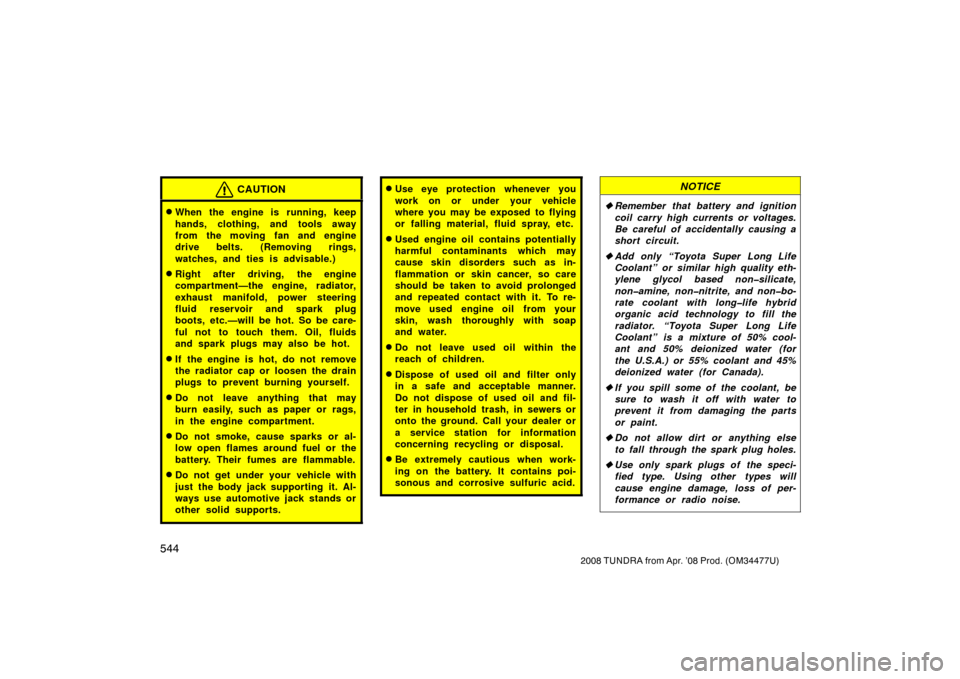Page 554 of 621

544
2008 TUNDRA from Apr. ’08 Prod. (OM 34477U)
CAUTION
�When the engine is running, keep
hands, clothing, and tools away
from the moving fan and engine
drive belts. (Removing rings,
watches, and ties is advisable.)
�Right after driving, the engine
compartment—the engine, radiator,
exhaust manifold, power steering
fluid reservoir and spark plug
boots, etc.—will be hot. So be care-
ful not to touch them. Oil, fluids
and spark plugs may also be hot.
�If the engine is hot, do not remove
the radiator cap or loosen the drain
plugs to prevent burning yourself.
�Do not leave anything that may
burn easily, such as paper or rags,
in the engine compartment.
�Do not smoke, cause sparks or al-
low open flames around fuel or the
battery. Their fumes are flammable.
�Do not get under your vehicle with
just the body jack supporting it. Al-
ways use automotive jack stands or
other solid supports.
�Use eye protection whenever you
work on or under your vehicle
where you may be exposed to flying
or falling material, fluid spray, etc.
�Used engine oil contains potentially
harmful contaminants which may
cause skin disorders such as in-
flammation or skin cancer, so care
should be taken to avoid prolonged
and repeated contact with it. To re-
move used engine oil from your
skin, wash thoroughly with soap
and water.
�Do not leave used oil within the
reach of children.
�Dispose of used oil and filter only
in a safe and acceptable manner.
Do not dispose of used oil and fil-
ter in household trash, in sewers or
onto the ground. Call your dealer or
a service station for information
concerning recycling or disposal.
�Be extremely cautious when work-
ing on the battery. It contains poi-
sonous and corrosive sulfuric acid.
NOTICE
�Remember that battery and ignition
coil carry high currents or voltages.
Be careful of accidentally causing a
short circuit.
� Add only “Toyota Super Long Life
Coolant” or similar high quality eth-
ylene glycol based non�silicate,
non�amine, non�nitrite, and non�bo-
rate coolant with long�life hybrid
organic acid technology to fill the
radiator. “Toyota Super Long Life
Coolant” is a mixture of 50% cool-
ant and 50% deionized water (for
the U.S.A.) or 55% coolant and 45%
deionized water (for Canada).
� If you spill some of the coolant, be
sure to wash it off with water to
prevent it from damaging the parts
or paint.
� Do not allow dirt or anything else
to fall through the spark plug holes.
� Use only spark plugs of the speci-
fied type. Using other types will
cause engine damage, loss of per-
formance or radio noise.
Page 567 of 621

557
2008 TUNDRA from Apr. ’08 Prod. (OM 34477U)
REPLACING YOUR TIRES
When replacing a tire, use a tire of
the same size and construction,
and the same or greater maximum
load as the originally installed
tires. Also, on four�wheel drive
models, all the tires must be the
same brand and have the same
tread patterns.
Using any other size or type of tire
may seriously affect handling, ride,
speedometer/odometer calibration,
ground clearance, and clearance be-
tween the body and tires or snow
chains.
Check that the maximum load of the
replaced tire is greater than 1/2 of the
Gross Axle Weight Ratings (GAWR)
of either the front axle or the rear
axle, whichever is greater. As for the
maximum load of the tire, see the load
limit at maximum cold tire inflation
pressure mentioned on the sidewall
of the tire, and as for the Gross Axle
Weight Ratings (GAWR), see the Cer-
tification Label. For details about the sidewall of the
tire and the Certification Label, see
“Tire information” on page 457 in
S ec t ion 2 and “Your Toy ot a’s
identification” on page 455 in Section
2.
CAUTION
Observe the following instruc-
tions. Otherwise, an accident
may occur resulting in death or
serious injuries.
�
Do not mix radial, bias belted,
or bias�ply tires on your ve-
hicle, as this may cause dan-
gerous handling characteris-
tics resulting in loss of control.
� Do not use tires other than the
manufacturer’s recommended
size, as this may cause danger-
ous handling characteristics
resulting in loss of control.
�Do not use tires of different
brands, sizes and construc-
tions. This may damage the
drive system and prevent the
vehicle stability control system
from functioning correctly.
� Four�wheel drive models:
Do not use tires of different
brands, sizes, construction or
tread patterns, as this may
cause dangerous handling
characteristics resulting in
loss of control.
Toyota recommends all four tires,
or at least both of the front or rear
tires be replaced at a time as a set.
See “If you have a flat tire” on page
503 in Section 4 for tire change proce-
dure.
When a tire is replaced, the wheel
should always be balanced.
Page 609 of 621
599
2008 TUNDRA from Apr. ’08 Prod. (OM 34477U)
FOR OWNERS
For owners
Reporting safety defects for U.S. owners 600
. . . . . . . . . . . . . . . . . . . . . .
Seat belt instructions for Canadian owners (in French) 600
. . . . . . . . . .
Camper information 602
. . . . . . . . . . . . . . . . . . . . . . . . . . . . . . . . . . . . \
. . . . .
SECTION 9
Page 610 of 621

600
2008 TUNDRA from Apr. ’08 Prod. (OM 34477U)
If you believe that your vehicle
has a defect which could cause a
crash or could cause injury or
death, you should immediately in-
form the National Highway Traffic
Safety Administration (NHTSA) in
addition to notifying Toyota Motor
Sales, U.S.A., Inc. (Toll−free:
1 −800 −331 −4331).
If NHTSA receives similar com-
plaints, it may open an investiga-
tion, and if it finds that a safety
defect exists in a group of ve-
hicles, it may order a recall and
remedy campaign. However,
NHTSA cannot become involved
in individual problems between
you, your dealer, or Toyota Motor
Sales, U.S.A., Inc. To contact NHTSA, you may call
the Vehicle Safety Hotline toll
−free
at 1 −888 −327 −4236 (TTY:
1 −800 −424 −9153); go to
http://www.safercar.gov ; or write
to: Administrator, NHTSA, 1200
New Jersey Ave, S.E.,
Washington, DC 20590. You can
also obtain other information about
motor vehicle safety from
http://www.safercar.gov.The following is a French explanation
of seat belt instructions extracted from
the seat belt section in this manual.
See the seat belt section for more de-
tailed seat belt instructions in English.
Reporting safety defects for
U.S. owners Seat belt instructions for
Canadian owners
(in French)—